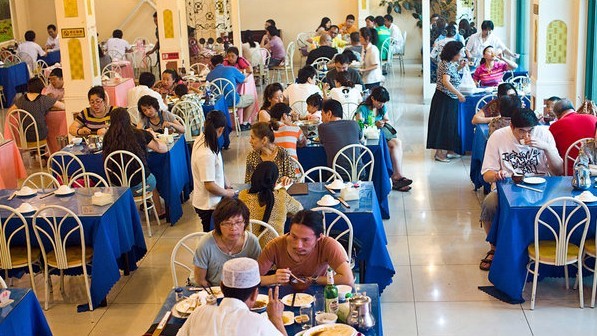Provincial eating in Beijing
 |
|
Diners at the Kashgar bureau restaurant in Beijing, one of the few in the city that serves authentic lamb rice pilaf.[Photo/The New York Times] |
Two thousand miles away from Yunnan and its sour papaya fish stews, Wang Li has driven half an hour with her family to Yunteng Shifu, which she considers the most authentic Yunnan restaurant in Beijing.
"The best thing about Beijing is its many provincial bureau restaurants," said Ms. Wang, 55, a retired doctor. "Stay in one place, eat from all over!"
Run by the Yunnan provincial government, Yunteng Shifu reproduces the region's subtropical fecundity with overflowing plastic green vines and neon cloth flowers. But the kitschy décor is not the allure: the no-frills focus here is on an affordable table full of authentic food that highlights pickled peppers, sour papayas and mushrooms.
In a nation of 1.3 billion people spread over 3.7 million square miles, culinary variation abounds. But you can find inauthentic Chinese cuisine everywhere in China. There is bad Sichuan food in Beijing, and bastardized Yunnan food in Sichuan. Still, who can fly to every province to sample local delicacies?
Beijing provides a time-lapsed way to explore authentic provincial cuisines. Each region has an office in the capital, a system that grew out of an administrative need to govern a vast country with absolute central power. The offices' administrative usefulness has withered in the telecommunications age, but the restaurants are among the few state-owned holdouts in a now fervently capitalist economy.
"They're government-run, pretty tacky, but they do the classic dishes and they do them well," said Eileen Wen Mooney, a Beijing food writer.
Dishes at Ms. Wang's favorite Yunnan restaurant (Yunteng Shifu, 7 Donghuashi Beili Dongqu; 86-10-6713-6439) taste of Southeast Asia, as the region borders Laos, Vietnam and Myanmar. The menu has pictures but no English. A good rule of thumb is to order mushrooms or anything red, which indicates a healthy portion of pickled peppers, the provincial specialty.
Dishes like shousiji (chicken salad with lemon grass, lime juice, pickled peppers and green onions) and liangbanbohe (mint salad with thin, flat tofu skin) are refreshingly light. A plate of zharulao showcases a regional oddity: goat cheese.
Chuanban Canting, run by the Sichuan government (5 Gongyuan Xijie Toutiao, Jiangguomennei Dajie; 86-10-6512-2277, extension 6101; scheduled to reopen in July after renovations) is the most famous of these restaurants and has earned an almost cultish devotion among the city's culinary cognoscenti. "Chuanban can be the best Sichuan restaurant in the city, depending on the mood of the chef," Ms. Mooney said.
Almost everything served here (the menu is in English and Chinese) is strewn with Sichuan peppercorns. On a recent visit, I tried the mapo tofu, which has a custardy texture, explosive opening kick and a lingering tingle dancing on your tongue.
Fame, of course, begets large crowds, so expect to wait unless you can sweet-talk the management in Sichuan dialect.
At the Guizhou restaurant (Guizhou Dasha Mudanting, 18 Yinghuajie, Hepingxiqiao, Beisanhuan Donglu; 86-10-6444-4466, extension 6203) you can find this southern province's most famous dish, suantangyu, made tangy and fragrant with a fermented tomato soup base. The menu is in Chinese and garbled English, and yes, that picture on the inside cover of the weighty menu is dog hotpot, another Guizhou specialty. Consider yourself warned.
You'll need a Chinese speaker to help decipher the Chinese, text-only menu at the Kashgar bureau (Kashi Fanzhuang, 60 Pen'er hutong; 86-10-6358-2243). Despite the ethnic tension in the restive, breakaway region of Xinjiang, Uighur food is hugely popular in Beijing.
This restaurant is one of the few in the city that serves authentic lamb rice pilaf, each grain plump but chewy, covered in a fragrant sheen of fat.


















